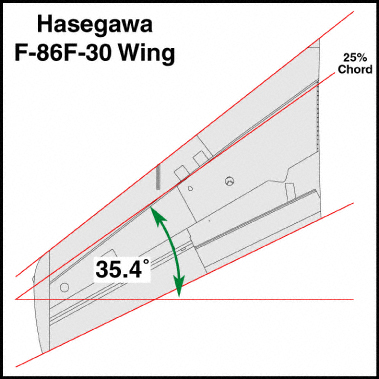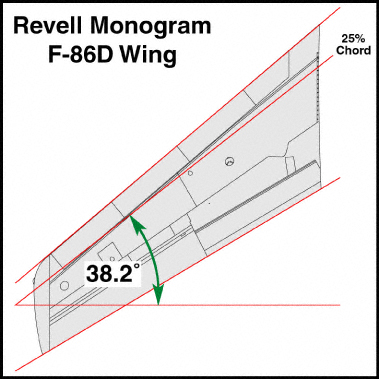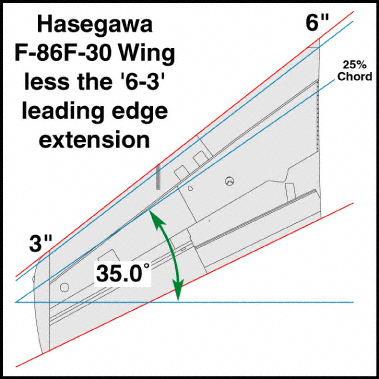|
1/48 Scale Sabre Wings
What's the
Angle?
by Jennings Heilig

HyperScale is proudly supported by
Squadron.com
When Hasegawa issued their beautiful series of 1/48 Sabres
starting in the mid-1990s, modellers (including me) were overjoyed.
The old Monogram kit was good in its day, and the ESCI kits were
fair, but we really needed a new technology Sabre family. At the
time the kit first came out there was some banter on
rec.models.scale about whether or not the wings had the correct
sweep. I honestly don't recall what the outcome of those discussions
was, but more was in store.
The recent appearance of the gorgeous Revell-Monogram 1/48 F-86D
with its narrow chord slatted wing reignited the debate right here
on HyperScale and some of the other modelling sites. Again, I don't
recall the exact course of this debate, but I do recall that at
least one review pronounced that the Dog Sabre's wings were correct
in sweep and that Hasegawa's (and it's near clone Academy's) were
not. As I recall it, the Hasegawa and Academy kits were alleged to
have too little sweep, against the RM Dog's correct sweep.
Well, the Sabre being one of my favorite subjects, I finally decided
the other day to sit down and straighten it out once and for all.
The Sabre's wing featured a 35 degree sweepback.
If you're not familiar with basic aerodynamic terminology, you
could easily believe that neither kit is correct. Many people
assume the sweep angle is measured along the leading edge of the
wing. Actually, the sweep angle is (usually) measured along a
theoretical line at 25% of the chord of the wing. So now you need to
know what the chord is, right? Quite simply, a wing's chord is the
distance from the leading edge to the trailing edge. If a wing is
perfectly rectangular, then the chord is constant from root to tip.
Most wings, like that of the Sabre, are tapered to some degree, thus
the chord at the tip is narrower than the chord at the root. So we
need to find the line which represents the average distance 25% of
the way from the leading to the trailing edge to figure our Sabre's
wing sweep angles.
In order to do that as accurately as possible, I got out some kit
parts, some paper, and a sharp pencil, and set to work with my
scanner, my trusty Power Mac G4, and Adobe Illustrator 8.0. My
methodology may not be "scientific", but my experience with this
sort of thing makes me believe that I'm certainly within a very
close tolerance on measurements.
I used the panel line where the wingtip joins the wing as a vertical
reference, since on the Sabre this panel line is parallel to the
longitudinal axis (and thus the line of flight) of the airplane. It
is this axis against which the wing sweep is measured. Both kit
wings were drawn using the same method, the same piece of paper, the
same scan, and were drawn at the same time to eliminate any errors
introduced from differing scanning parameters, etc.
I aligned both kit left hand upper wing halves on a vertical
reference line, carefully aligning the common panel line on both to
my reference. I taped the wing parts down and using a sharp drafting
pencil, precisely traced the leading and trailing edges onto the
paper. I was careful to keep my pencil very sharp and to make the
line as precisely even with the edges of the plastic as possible.
Then I scanned this piece of paper in at 720dpi in 'line art' mode
at 100% of actual size. This provided me with a black & white TIFF
image in very high resolution and at exactly the same size as the
original tracing.
This TIFF was then imported into Adobe Illustrator. I laid down
lines along the leading and trailing edges of the tracing, being
sure to have my vertical reference line exactly vertical on my
Illustrator document. I then used Illustrator's "blend" option, set
to blend the leading and trailing edge lines in three equal steps.
This gave me precisely evenly spaced lines at 25%, 50%, and 75% of
the chord along the entire span. Since the 50% and 75% lines were
not needed, I discarded them.
Using Illustrator's measurement tool, I then measured the precise
angle of each of my 25% chord lines. The results are as you see. The
tool caculates angles out to .001 degree, but since my eye can't
discern a thousandth of a degree, I rounded to the nearest tenth.


Now, that should pretty well wrap it up, right? Well, not so
fast.
The Hasegawa and Academy wings represent the hard edged, extended
chord '6-3' wing of the F-86F. If you understand that the '6-3'
refers to the amount added to the leading edge; 6 inches at the
root, and 3 inches at the tip, then you can see that this
modification will affect the sweepback of the wing if we measure our
25% chord based on this unevenly extended leading edge. Remember
that the 35 degree sweep of the wing was calculated on the original
F-86 wing, long before the '6-3' leading edge extension had been
dreamed up.
So back to Illustrator.
I took the tracing of the Hasegawa wing and measured (down to 3
decimal places of accuracy) 6 scale inches back from the leading
edge at the root, and 3 scale inches back at the tip (along the
vertical reference line). When I then went back and had Illustrator
calculate the 25% chord line from these new lines, bango! It
measured out at exactly 34.95 degrees, which is close enough to 35
in my book, and I'm pretty anal-retentive!

So, who's right and who's wrong?
It appears, even factoring in a small amount of error in the
abovementioned methodology, that Hasegawa and Academy got it bang on
the money, and that Revell Monogram... well, they didn't. The Dog
Sabre, gorgeous kit that it is, has a wing that's swept more than 3
degrees beyond what it should have.
All of the above aside, all of the kits certainly look like
Sabres. Unless you had a Hasegawa and a Revell-Monogram sitting side
by side and could view them from directly above, against a gridded
surface, and were really anal about it, I doubt that you'd
spot the difference.
I'm completely open to being shown to be all wet on this, but I, for
one, am now satisfied that the Hasegawa and Academy F-86 kits are
the most accurate F-86F kits, and that the Revell-Monogram F-86D is
the most accurate Dog Sabre out there, despite its slightly
too-swept wings.
Let us go forth and build!
Text and Images Copyright © 2003 by
Jennings Heilig
Page
Created 25 March, 2003
Last updated
25 March, 2003
Back to HyperScale Main
Page
Back to Reviews
Page
|
Home |
What's New |
Features |
Gallery |
Reviews |
Reference |
Forum |
Search